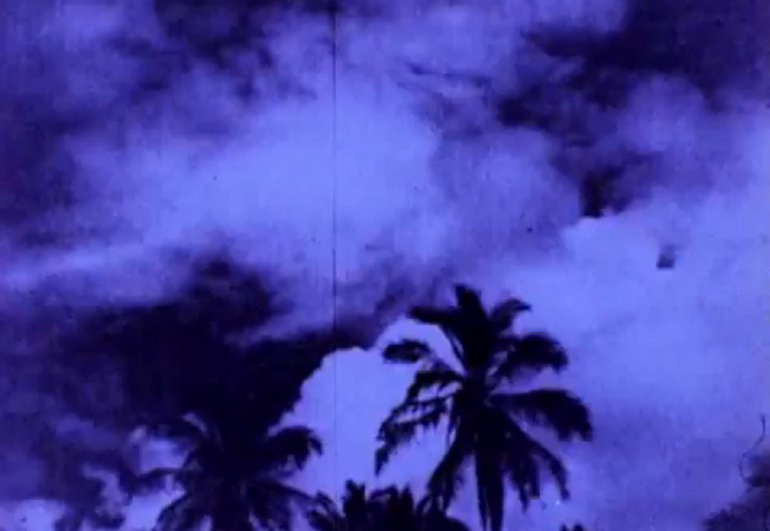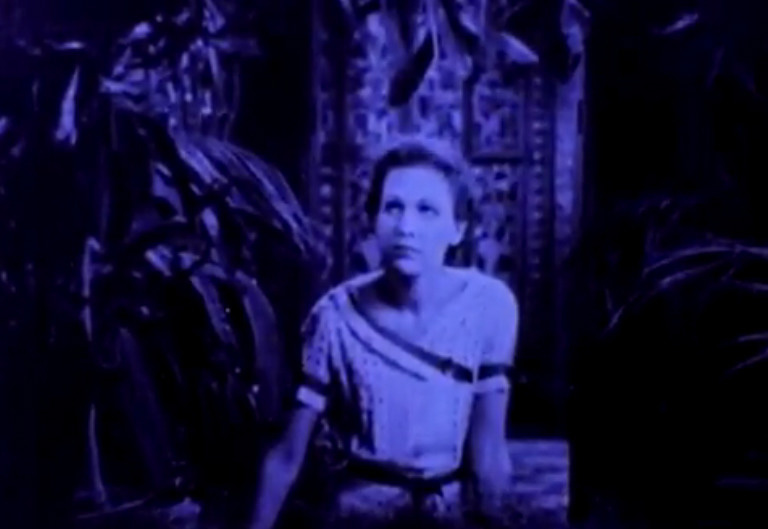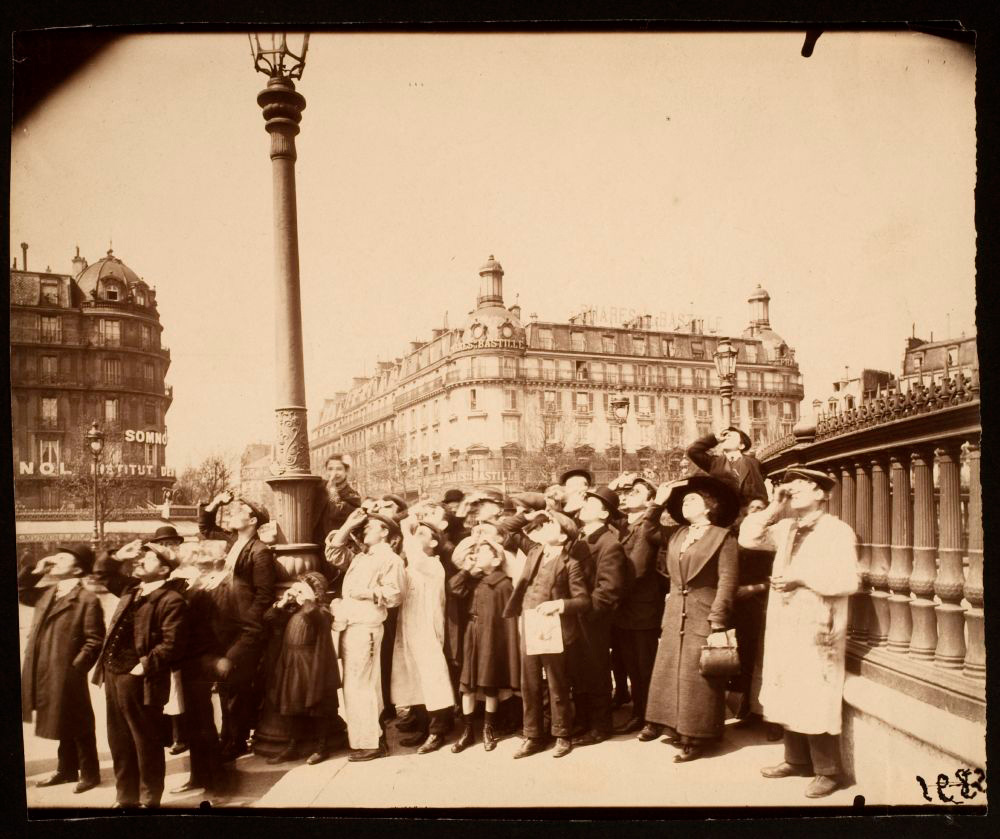Surrealist Astronomy in the South Pacific: Joseph Cornell and the Collaged Eclipse
by Catherine Corman

Joseph Cornell, still from Rose Hobart, 1936. 16 mm film, 20 min. Image use by permission from the Museum of Modern Art, New York.
At the first screening of Joseph Cornell’s film Rose Hobart, in December 1936, Salvador Dalí knocked over the projector with his umbrella and screamed in Spanish at a bewildered Cornell. Cornell fled but later asked Julien Levy, in whose New York gallery the film had shown, “Why, why—when he is such a great man and I am nobody at all?”1 The answer eventually came from Dalí’s wife Gala; her husband had proclaimed, “Joseph Cornell, you are a plagiarist of my unconscious mind!” As it turned out, Dalí had an idea for a very similar film but had never told anyone. He was convinced that nothing like it existed anywhere but in his own mind, so the only way Cornell could have had the same idea was to have stolen it from Dalí’s unconscious.
Cornell had taken footage from the 1931 jungle adventure film East of Borneo, chopped it up, reordered it, and discarded the entire plot, focusing on the ambiguity of the characters’ emotions and the quivering, halting beauty of the starlet Rose Hobart.2He disposed of traditional narrative; he cut out reaction shots, so we rarely know to whom Rose is speaking or to what she is reacting; he drew moments from different scenes together to happen in succession, sometimes adding in reversed clips with carefully calibrated eyeline matches as a further filmic trompe l’oeil; and he removed overtly upsetting scenes. He also made the film seem deliberately modest and worn. The legendary film theorist P. Adams Sitney describes the film’s aestheticization of decay: “passages are damaged and strange ellipses occur in their repair… Cornell made these accidents of deterioration the formal model for his first film.” 3 Cornell’s intentions remain unclear. Even today there is no particular consensus on the meaning of the film, or how Cornell perceived its significance. With the exception of Dalí, the film’s first audience found Rose Hobart incomprehensible and inept.
Cornell’s film was radical, shocking and new, but also faded, sentimental and deliberately obsolete. Cornell wanted to re-create the lost art of the silent film, whose era had recently vanished with the advent of the first talking picture, The Jazz Singer, in 1927. Cornell longed for “the poetic and evocative language of the silent film, if only in whispers at times, beside the empty roar of the soundtrack,” and sought the recently lost “world of expressive silence” amid the chaos of the new talking films. He continued, “Among the barren wastes of the talking films there occasionally occur passages to remind one again of the profound and suggestive power of the silent film to evoke an ideal world of beauty, to release unsuspected floods of music from the gaze of a human countenance in its prison of silver light.” 4 To transform the talkie East of Borneo into the silent film Rose Hobart, Cornell removed the soundtrack, played a record of Brazilian music at each screening, slowed the film down to silent speed (16 frames per second versus sound speed’s 24), and projected the film through a colored filter. Using close-up shots and featuring gesture (rather than speech) as a primary language, he tried to return to the methods and moods of silent film. “By projecting Rose Hobart at silent speed,” writes Sitney, “Cornell retarded the gestures and action of East of Borneo, not enough to make them look like slow motion, but to lend them a nuance of elegance and protraction.”
Cornell expressed his longing for the poetic ballet of the vanished art form of silent film in an appreciation of the actress Hedy Lamarr, in which he compared the meditative hush and poetry of silent films to Renaissance portraiture. “It is as though the camera had been presided over by so many apprentices of Caravaggio and Georges de la Tour,” he writes. “The studio props fade out and there remains a drama of light of the tenebroso painters… [Lamarr] will become enveloped in the warmer shadows of Rembrandt.” In Rose Hobart, Cornell attempted to create a Renaissance portrait out of a middling actress in a throwaway jungle picture. His Mona Lisa is Rose Hobart, an actress who was so little known that, by the end of her life, she was nearly denied entrance into an old age home for former actresses: her films had been discarded after screening in theaters, and she had trouble proving that she had ever actually been an actress. The film scholar Chris Chang finds this “homage to an actress who was never enough of a star to be properly forgotten … an exemplary bit of Cornellian poetry.” 5But perhaps this furthered Cornell’s purpose. Hobart’s lack of established identity adds to her mystery. Like the subjects of so many Renaissance portraits, she is faintly familiar, subtly engaging, and opaquely inaccessible. With her voice dissolved and the narrative in which she exists obscured, she becomes as much a blank slate as an artist’s model. Subtracting words and plot adds to her ethereality. “The tenebroso of light creates affective states that are not translatable into story,” write the critics Herman Rapaport and Renee Judd. “The figure of Rose Hobart merely gesticulates furtively and claustrophobically against an irrational and implacable alternation of light.” 6In an article in October, the artist and critic Thomas Lawson stresses the importance of Hobart’s remoteness, writing that she “must remain out of reach if she is to retain her ability to represent a fantasy.” Without a narrative to give the scenes structure or meaning, he writes, they “lose their individuality, pointing instead to a latent meaning not manifest in a catalogue of the discrete elements. As she moves around the twilight space of the film, strangely silent, paying no attention to the raucous music on the soundtrack, Rose Hobart becomes almost invisible.” 7
Hobart’s ethereality evokes transcendent, eternal beauty, and private desire. The cataloguer of the avant-garde J. Hoberman called Rose Hobart “the greatest film fetish of all, made for a cult of one.” 8 Sitney saw the film as beauty broken free from the morass, “a breathtaking example of the potential for surrealistic imagery within a conventional Hollywood film once it is liberated from its narrative causality.” Sitney makes of Rose Hobart a midtown-Manhattan, interwar avant-garde illustration of Michelangelo’s legendary one-sentence manifesto, “I saw the angel in the marble and carved until I set him free.”

Joseph Cornell, still from Rose Hobart, 1936. 16 mm film, 20 min. Image use by permission from the Museum of Modern Art, New York.
The Surrealists prefigured Rose Hobart with their invention of synthetic criticism, which scholar Marguerite Bonnet describes as “reject[ing] any attempt to analyze the work, [trying instead] to suggest the impression it made on them by establishing a poetic equivalence.” 9 André Breton undertook a Surrealist approach to film, modeled on the ideal of the flâneur, wandering from cinema to cinema, watching a few scenes of one film before moving on to the next, in his words, “releasing the imagery from the shackles of narrative.” “We do not have any talent,” Breton wrote, “[but have instead] made ourselves into simple receptacles of so many echoes, modest recording instruments.” 10 The film theorist Christian Keathley describes the Surrealists’ urgency in experimenting with such practices, as they saw other art forms around them growing irrelevant or inadequate. “They believed that automatic means could do what conventional art-making practices were losing their capacity for: revealing what Breton called ‘the marvelous embodied in the everyday.’ ” 11
By creating his poetic collage film out of a lowbrow popular jungle film, Cornell, as Hoberman writes, “revealed an evocative, dreamlike, latent content in his found Hollywood potboiler.” If Hollywood films translate the contemporary cultural psyche into images, Cornell plumbed East of Borneo for glimpses of the contemporary collective unconscious. But he went even further, searching for the limits of consciousness itself. The original linear narrative of East of Borneo was completely broken, replaced with images in a succession that evokes the processes of the untamed mind. The film works like a dream or a hidden memory, moving associatively; filled with repetition; flashing back to a moment of heightened tension we have seen earlier but whose import is not clear; circling again and again through a few related but obscure moments, as if trying to decipher them by reviewing them; jumping to an image from an entirely different context that feels uncannily similar to what we have just seen. As Sitney writes, “Joseph Cornell describes the marginal area where the conscious and the unconscious meet.” 12
But where, ultimately, does this leave us? “Each of its curiously reset features astonishes us with new meaning,” writes Sitney. Does Rose Hobart reject meaning or offer a surfeit of it? The slipperiness of meaning is expressed in a story Sitney relates about the film’s title:
Cornell once told me he was considering changing the title of the film from Rose Hobart to Tristes Tropiques. I asked if he had been reading Lévi-Strauss, but he told me he hadn’t. He encountered the title in Susan Sontag’s Against Interpretation, which attracted his attention after she wrote a review of a newly reissued book on Surrealism… The words themselves seemed peculiarly appropriate. They had the distance of French, a language he loved; they had alliteration; and perhaps most important they point to the fundamental sadness underlying the humor and pleasures of his first collage film.13
The title Tristes Tropiques provides an associative, impressionistic form of meaning, in which a title might trigger an emotional response more powerful than its semantic connotations. It also may have held a less than accidental allure for Cornell. In 1919, an astronomer photographed the positions of stars during an eclipse in an attempt to prove Einstein’s general theory of relativity. Photographs of the stars would demonstrate that space curved around large bodies, if the stars’ movement fit the theory’s predictions. For the next decade, these investigations continued in exotic lands with optimal eclipse-viewing conditions.
In 1930, as East of Borneo was being made, a team of scientists descended on the remote volcanic island of Niuafo’ou to view an eclipse. The island was, in the art historian Kirsten Hoving’s words, an “isolated palm-covered speck of land in the Pacific which had never before seen a scientist.” 14 Excited press covered the expedition. The King of Tonga promised to visit the island to watch the eclipse. Cornell, an avid stargazer who kept dossiers on constellations and heavenly bodies and subscribed to at least one journal of astronomy, was likely aware of this expedition. In 1934, two years before Rose Hobart was first screened, Dr. Willi M. Cohn, leader of the American Eclipse Expedition, journeyed to a “little coral island to witness the St. Valentine’s Day total solar eclipse.” 15 The shadow of the moon first appeared over Borneo, its path passing over the coral island, and then, as Hoving describes it, “seeming to plunge into the sea with sunset.” 16 The best viewing place for this eclipse was the coral island between Borneo and the point where the path of the eclipse fell into the water. This island was located east of Borneo.
In the final scene of Rose Hobart, an eclipse occurs, and the sun appears to fall out of the sky, into the water.17Cornell edited in footage of a white ball (standing in for the sun) falling into water, leaving pulsing ripples after it disappears beneath the surface. Sitney calls the eclipse “the crucial natural event” of the film and writes that the entire montage is organized around it. The film is organized not in a linear narrative, but in the way the unconscious mind orders dreams, returning to certain images, propelled by emotion, always driving, not in a logical fashion, but by means of association and repetition, toward this ultimate event, the sun falling down out of the sky into the water.
The confusion of time also hinted at the eclipses in Niuafo’ou and the coral island, as both eclipses started a day after they ended. As Cohn explained, “The eastward sweep of the shadow carries it across the international date line. This produces the strange effect of an eclipse beginning in one part of the world on Wednesday and ending more than three hours later in another part of the world on Tuesday.” In Rose Hobart, when the sun finally does fall out of the sky, it is only the size of an egg. Sitney describes “the filmmaker’s poetic invention of a sun that is literally no bigger than it appears to be when seen from the earth. [With] this shift from figurative to literal scale … the sun of Rose Hobart is nothing more than a more convincing prop… In Cornell’s collage-cinema, imagery never carries its full weight.” 18

Eugene Atget, L’Eclipse, 1912. Albumen print, 6 x 8 in. Courtesy of the George Eastman House Collection.
This is Surrealist astronomy. The terrifying, awe-inspiring event in the dream is only a small image in waking life. It falls out of sight and disappears into the depths of the waters of our unconscious, like the sun in Rose Hobart. The first image in Rose Hobart does not come from East of Borneo, but was inserted by Cornell from another source. It shows a small crowd, heads tilted to the sky, watching an eclipse. This echoes Eugene Atget’s photograph L’Eclipse (1912), which Man Ray put on the cover of the journal La Révolution Surréaliste in 1926. 19 In the photograph, people are gathered on a bridge, looking up at the sky through special filters. Keathley writes that Rose Hobart shows us “the way in which Cornell himself watched the 1931 Hollywood potboiler East of Borneo.” 20 But the way Cornell perceived East of Borneo was informed by his understanding of the implications of eclipses for a new formulation of the laws of the universe, and the synthetic criticism of the Surrealists, who wandered from cinema to cinema, making a new form of art that consisted only of absorbing and collaging the art that preceded them.
Cornell watched East of Borneo as no one else could have. He saw it as a flâneur, like Breton, skipping from scene to scene until he had created his own film. He saw it as a Surrealist who was so thoroughly Surrealist, he was able to rob the mind of Dalí from across the ocean. He watched it with a longing for the lost arts it evoked and with a yearning for what lay beyond the conscious mind. East of Borneo was where the sun fell out of the sky and into the ocean. It was where scientists could finally see proof of what they were certain was true but yearned to confirm. The photographs of the heavens that might verify their closely held and mystifying belief could not be taken within the limits of the civilized world, but only from a volcanic island where time reversed itself.